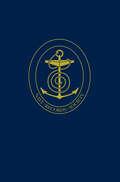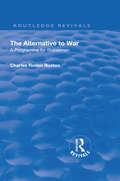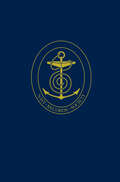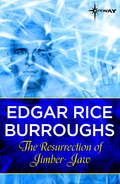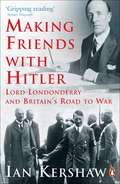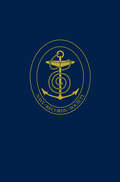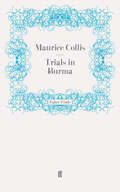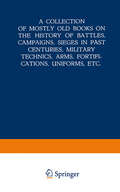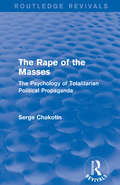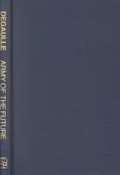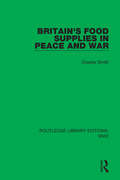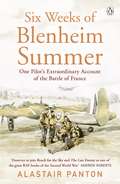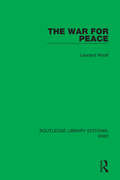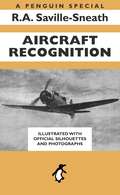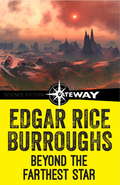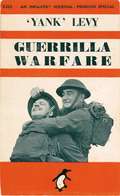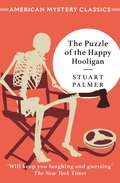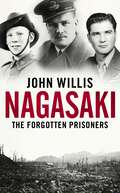- Table View
- List View
The Private Papers of John, Earl of Sandwich: 1771-1782, Vol. III
by G.R. Barnes J.H. OwenThe Fourth Earl of Sandwich was First Lord of the Admiralty (for the third time in his long career) from 1771 to 1782. Blamed by the Whig opposition for many of the disasters of the American War, he was additionally loaded by 19th-century Whig historians with the false image of a corrupt libertine.It was the publication of these volumes of his correspondence and papers (then in the family home, now in the National Maritime Museum), covering the years 1771 to 1782, which restored his reputation as a conscientious and imaginative naval administrator and reformer, especially of the dockyards and of the timber question. Without entirely rescuing his status as a strategist, they showed very clearly the weaknesses at the heart of the North administration which damaged its handling of the war, and undermined Sandwich’s efforts.A fifth volume intended to cover his handling of naval patronage was overtaken by the war.This volume is from May 1779 to December 1780.
Revival: A Programme for Statesmen (Routledge Revivals)
by Charles Roden BuxtonThis book faces the problem of the "dissatisfied" Powers. It recognizes the dangers of war, but it suggests a clear alternative. The League is not dead, it contends: it has only failed because it has attempted to do the impossible, namely to preserve and guarantee a new status quo which is unjust. Until this is changed, no system of treaties and pacts, however perfect, will work. It is not denied that to make the necessary concessions will require a great effort of comprehension and sympathy. But it can be done, and a programme is put forward which, while idealistic in its ultimate aims, confines itself within the limits of what is strictly practicable.
Revival: A Programme for Statesmen (Routledge Revivals)
by Charles Roden BuxtonThis book faces the problem of the "dissatisfied" Powers. It recognizes the dangers of war, but it suggests a clear alternative. The League is not dead, it contends: it has only failed because it has attempted to do the impossible, namely to preserve and guarantee a new status quo which is unjust. Until this is changed, no system of treaties and pacts, however perfect, will work. It is not denied that to make the necessary concessions will require a great effort of comprehension and sympathy. But it can be done, and a programme is put forward which, while idealistic in its ultimate aims, confines itself within the limits of what is strictly practicable.
The Barrington Papers: Vol. I
by D. Bonner-SmithSamuel Barrington (1729-1800), a son of the first Viscount Barrington, entered the Royal Navy in 1740. He was posted in 1747 and eventually was promoted to Admiral in 1787.Papers in the possession of Barrington’s collateral descendants form these two volumes and cover his naval career. They comprise order books (1747-71), a private letter book (1770-99), his journal and three bound documents relating to the Leeward Islands command (1778-79), some loose correspondence, and printed matter: the general sailing and fighting Instructions, two signal books, and instructions. None of Barrington’s public letter books survives.This includes Barrington’s negotiations at Tetuan to release British subjects held by the Barbary corsairs, and his cruising off the coast of Guinea where some Royal Navy captains had been personally profiting from commercial dealings including the transportation of slaves.Commanding the 60-gun Achilles, he served from 1757-59 off the coast of France, in 1760 under Captain the Hon John Byron destroying the fortifications of Louisbourg in North America, and in 1761 under Commodore Augustus Keppel in the operations against Belle-Île. From 1762 until the 1763 Treaty of Paris, he commanded the 74-gun Hero. From 1768, when he again took to sea, until 1778 when he received his flag, he saw service in the dispute with Spain over the Falkland Islands (1771) and in the Channel.
The Barrington Papers: Vol. I
by D. Bonner-SmithSamuel Barrington (1729-1800), a son of the first Viscount Barrington, entered the Royal Navy in 1740. He was posted in 1747 and eventually was promoted to Admiral in 1787.Papers in the possession of Barrington’s collateral descendants form these two volumes and cover his naval career. They comprise order books (1747-71), a private letter book (1770-99), his journal and three bound documents relating to the Leeward Islands command (1778-79), some loose correspondence, and printed matter: the general sailing and fighting Instructions, two signal books, and instructions. None of Barrington’s public letter books survives.This includes Barrington’s negotiations at Tetuan to release British subjects held by the Barbary corsairs, and his cruising off the coast of Guinea where some Royal Navy captains had been personally profiting from commercial dealings including the transportation of slaves.Commanding the 60-gun Achilles, he served from 1757-59 off the coast of France, in 1760 under Captain the Hon John Byron destroying the fortifications of Louisbourg in North America, and in 1761 under Commodore Augustus Keppel in the operations against Belle-Île. From 1762 until the 1763 Treaty of Paris, he commanded the 74-gun Hero. From 1768, when he again took to sea, until 1778 when he received his flag, he saw service in the dispute with Spain over the Falkland Islands (1771) and in the Channel.
The Resurrection of Jimber-Jaw: Large Print
by Edgar Rice BurroughsJimber-Jaw awakens to find his world has changed and it is now the twentieth century!
Making Friends with Hitler: Lord Londonderry and Britain's Road to War
by Ian KershawBritain, as the most powerful of the European victors of World War One, had a unique responsibility to maintain the peace in the aftermath of the Treaty of Versailles. The outbreak of a second, even more catastrophic war in 1939 has therefore always raised painful questions about Britain's failure to deal with Nazism. Could some other course of action have destroyed Hitler when he was still weak? In this highly disturbing new book, Ian Kershaw examines this crucial issue. He concentrates on the figure of Lord Londonderry - grandee, patriot, cousin of Churchill and the government minister responsible for the RAF at a crucial point in its existence. Londonderry's reaction to the rise of Hitler-to pursue friendship with the Nazis at all costs-raises fundamental questions about Britain's role in the 1930s and whether in practice there was ever any possibility of preventing Hitler's leading Europe once again into war.
The Private Papers of John, Earl of Sandwich: 1771-1782, Vol. IV
by G.R. Barnes J.H. OwenThe Fourth Earl of Sandwich was First Lord of the Admiralty (for the third time in his long career) from 1771 to 1782. Blamed by the Whig opposition for many of the disasters of the American War, he was additionally loaded by 19th-century Whig historians with the false image of a corrupt libertine.It was the publication of these volumes of his correspondence and papers (then in the family home, now in the National Maritime Museum), covering the years 1771 to 1782, which restored his reputation as a conscientious and imaginative naval administrator and reformer, especially of the dockyards and of the timber question. Without entirely rescuing his status as a strategist, they showed very clearly the weaknesses at the heart of the North administration which damaged its handling of the war, and undermined Sandwich’s efforts.A fifth volume intended to cover his handling of naval patronage was overtaken by the war.This volume is from 1781 to 1782. The planned fifth volume was never completed.
The Private Papers of John, Earl of Sandwich: 1771-1782, Vol. IV
by G.R. Barnes J.H. OwenThe Fourth Earl of Sandwich was First Lord of the Admiralty (for the third time in his long career) from 1771 to 1782. Blamed by the Whig opposition for many of the disasters of the American War, he was additionally loaded by 19th-century Whig historians with the false image of a corrupt libertine.It was the publication of these volumes of his correspondence and papers (then in the family home, now in the National Maritime Museum), covering the years 1771 to 1782, which restored his reputation as a conscientious and imaginative naval administrator and reformer, especially of the dockyards and of the timber question. Without entirely rescuing his status as a strategist, they showed very clearly the weaknesses at the heart of the North administration which damaged its handling of the war, and undermined Sandwich’s efforts.A fifth volume intended to cover his handling of naval patronage was overtaken by the war.This volume is from 1781 to 1782. The planned fifth volume was never completed.
Trials in Burma
by Maurice Collis"This is an unpretentious book, but it brings out with unusual clearness the dilemma that faces every official in an empire like our own." George OrwellTrials in Burma recounts Maurice Collis' experiences as a district magistrate in Rangoon in the late 1920s. The book recounts his gradual realisation that far from administering an impartial system of justice, he is expected to protect British interests. In a cool dispassionate style, Collis describes how, by choosing integrity over career, he eventually loses his job."A brilliant, direct and extraordinarily vivid account of this troubled period...a masterly survey of the Burmese scene." Daily Mail
A Collection of Mostly Old Books on the History of Battles, Campaigns, Sieges in Past Centuries, Military Technics, Arms, Fortifications, Uniforms, Etc.
by Martinus NijhoffRoutledge Revivals: The Psychology of Totalitarian Political Propaganda (Routledge Revivals)
by Serge ChakotinFirst published in French in 1939, and later in English in 1940, this work by the author, analyses and strongly critiques the effect of Nazi propaganda on the psychology of the masses. By bringing together the political and the psychological, the author refers to the use of propaganda in order to serve the ends of a handful of men as ‘psychical rape’ and warns that this phenomenon cannot be attributed solely to the Nazi regime. The English translation was updated to account for the outbreak of the Second World War in 1939. It will be of great interest to anyone studying the Second World War, Nazism, Fascism and the psychology of propaganda.
Routledge Revivals: The Psychology of Totalitarian Political Propaganda (Routledge Revivals)
by Serge ChakotinFirst published in French in 1939, and later in English in 1940, this work by the author, analyses and strongly critiques the effect of Nazi propaganda on the psychology of the masses. By bringing together the political and the psychological, the author refers to the use of propaganda in order to serve the ends of a handful of men as ‘psychical rape’ and warns that this phenomenon cannot be attributed solely to the Nazi regime. The English translation was updated to account for the outbreak of the Second World War in 1939. It will be of great interest to anyone studying the Second World War, Nazism, Fascism and the psychology of propaganda.
The Army of the Future (PDF)
by Charles De GaulleCharles de Gaulle's book The army of the future is the ground force version of Giulio Douhet's Command of the Air. de Gaulle describes what his vision of what mobile warfare would be in the future. He begins the book with a very interesting terrain analysis explaining why France has always been open to invasion. From there he describes what a division would look like containing two tank brigades, mechanized infantry, self propelled artillery, engineers, air defense, aviation and logistics. He also describes how these mobile divisions would fight. He explains what type of individuals would be needed to fill the ranks of this highly professional mobile army. My opinion that de Gaulle's vision is closer to the Heavy Divisions of the Cold war is based on de Gaulle calling for two Tank Brigades in his division while the German army of WWII had only one Panzer Regiment in their Panzer Divisions. Also the German Army relied heavily on horse transportation for most all of their artillery. A US Tank Division during the Cold War had two Tank and one Mechanized Infantry Brigade, all artillery was self propelled, this organization was more in line with de Gaulle's division than the Panzer Division was. That said, de Gaulle's vision for ground warfare was far more accurate than Douhet's vision for air power was.
Britain's Food Supplies in Peace and War (Routledge Library Editions: WW2 #3)
by Charles SmithThis book, first published in 1940, is a systematic analysis of Britain’s principal food supplies and the means by which they are distributed to the people. Its calculates the total quantities of food required to feed the whole nation properly, examines pricing structures and the sources of the food stuffs. Both home produced and imported foods are covered in this survey, as are restrictions in the form of the wartime governmental controls.
Britain's Food Supplies in Peace and War (Routledge Library Editions: WW2 #3)
by Charles SmithThis book, first published in 1940, is a systematic analysis of Britain’s principal food supplies and the means by which they are distributed to the people. Its calculates the total quantities of food required to feed the whole nation properly, examines pricing structures and the sources of the food stuffs. Both home produced and imported foods are covered in this survey, as are restrictions in the form of the wartime governmental controls.
Six Weeks of Blenheim Summer: One Pilot’s Extraordinary Account of the Battle of France
by Alastair Panton'DESERVES TO JOIN REACH FOR THE SKY AND THE LAST ENEMY AS ONE OF THE GREAT RAF BOOKS OF THE SECOND WORLD WAR' - ANDREW ROBERTSAs I write, I can clearly recall the stinging heat of aburning Blenheim, smells, tastes, expressions, sounds of voices and, most ofall, fear gripping deep in me.Flying Officer Alastair Panton was just twenty-three when his squadron deployed across the Channel in the defence of France. They were desparate days.Pushed back to the beaches as the German blitzkrieg rolled through the Low Countries and into France, by June 4th 1940 the evacuation ofthe Allies from Dunkirk was complete. A little over two weeks later France surrendered.Flying vital, dangerous, low-level missions throughout the campaign in support of the troops on the ground, Panton's beloved but unarmed Bristol Blenheim was easy meat for the marauding Messerschmitts. At the height of fighting he was losing two of his small squadron's crews to the enemy every day.Discovered in a box by his grandchildren after his death in 2002, Alastair Panton's Six Weeks of Blenheim Summeris a lostclassic. One of the most moving, vivid and powerful accounts of war inthe air ever written. And an unforgettable testament to the courage, stoicism, camaraderie and humanity of Britain's greatest generation.'THE BEST ACCOUNT OF THE CHAOS AND CONFUSION OF WAR OUTSIDE THE PAGES OF EVELYN WAUGH' BORIS JOHNSON'ONE CAN'T HELP FEELING AWE AND REVERENCE. THERE ARE ENOUGHEDVENTURES HERE FOR A LIFETIME'LOUIS DE BERNIERES'SIMPLY WONDERFUL. ONE OF THE BEST ACCOUNTS OF WWii I HAVE EVER READ'JOHN NICHOL
The War for Peace (Routledge Library Editions: WW2 #40)
by Leonard WoolfIn this book, first published in 1940, Leonard Woolf lays out the necessity for the establishment of a system providing for the rule of international law and cooperation, control of international power and collective defence against international aggression. He lays bare the issues at stake in the Second World War and draws lines on which a lasting peace could be framed.
The War for Peace (Routledge Library Editions: WW2 #40)
by Leonard WoolfIn this book, first published in 1940, Leonard Woolf lays out the necessity for the establishment of a system providing for the rule of international law and cooperation, control of international power and collective defence against international aggression. He lays bare the issues at stake in the Second World War and draws lines on which a lasting peace could be framed.
Aircraft Recognition: A Penguin Special
by R.A. Saville-SneathWhen this book was first published in 1941, aircraft recognition was far more than just a pleasant pastime; it was often a matter of life and death… This classic text provides a definitive catalogue of the aeroplanes, enemy and friendly, seen over British skies during the Second World War. R.A. Saville-Sneath set out to produce a handy classification guide, with many diagrams, a full glossary and some useful mnemonics, showing how each type of aircraft could be identified quickly and easily. The basic structures, tail units, positions of the wings and engines, and even the sounds made by the different planes, form part of the essential 'vocabulary' for distinguishing Albacores and Ansons, Beauforts and Blenheims, Heinkels, Hurricanes and Junkers, Messerschmitts and Moths, Spitfires and Wellingtons. For anyone interested in aviation the book provides a mine of information about a golden age. For those who lived through one of the most glorious episodes in the history of combat it will prove vividly evocative of those extraordinary days.
Beyond the Farthest Star: Large Print
by Edgar Rice BurroughsOn Poloda, a world far beyond the reach of any telescope on Earth, there appeared a mysterious being. The inhabitants called him Tangor - 'from nothing' - and enlisted him in their savage warfare. And Tangor, the Earthman so strangely transported to a remote planet, took part in one thrilling adventure after another in the battles which were so like, yet unlike, those of his own twentieth century.
Guerrilla Warfare
by 'Yank' Levy1941. Britain is under some of the heaviest air raids of the Second World War. Concerns about Nazi paratroopers landing in Britain and invading take hold in the hearts of the British citizenry. The Home Guard has been mobilised to defend against airborne assault – and it needs training. ‘Yank’ Levy is brought in to Osterley Park to teach guerrilla warfare, from practical experience in the Spanish Civil War. ‘Yank’ trains soldiers of the Home Guard how to use surveillance, defend against tanks and armoured vehicles, how to fight in towns and across country and against a well-supplied, highly-trained and mobile occupying force. His book, Guerrilla Warfare offers such sound advice as: ‘Whether you go to a tea-party or to work on your allotment…take your rifle with you. Don’t leave it downstairs for a German to grab if he enters the house’ and 'Your motto should always be: ‘Finish them! Then a quick get-away, and another ambush some place else’’
Odor of Violets: A Duncan Maclain Mystery
by Baynard KendrickIt's world war 2, and a blind detective follows unseen clues to solve a murder and undermine a German spy plot.'Thrilling and perilous adventures' NEW YORK TIMESCaptain Duncan Maclain was blinded during his service in the first World War. Now he is one of New York City's most sought-after detectives, achieving a mastery of the subtle unseen clues often missed by those who see only with their eyes. Now, with the outbreak of a second world war, Maclain is pulled into a case unlike any he's investigated before. Aided by his dogs Schnucke and Driest, the Captain puts the intelligence-gathering techniques he learned in the Army to work on a case involving German spies, where it is almost impossible to tell whose side anyone is on.
The Puzzle of the Happy Hooligan
by Stuart PalmerIt's murder on a film set...'Will keep you laughing and guessing from the first page to the last' NEW YORK TIMESHildegarde Withers is just your average school teacher but with above-average skills in the art of deduction. She often finds herself investigating crimes led only by her own meddlesome curiosity, though her friends on the NYPD don't mind when she solves their cases for them. After plans for a grand tour of Europe are interrupted by Germany's invasion of Poland, Miss Withers heads to Los Angeles instead, where her vacation finds her working as a technical advisor on the set of a film adaptation of the Lizzie Borden story. But the producer's plans for an epic retelling of the historical killer's murder-spree are derailed when a screenwriter turns up dead...
Nagasaki: The Forgotten Prisoners
by John WillisThis is one of the most remarkable untold stories of the Second World war. At 11.02 am on an August morning in 1945 America dropped the world's most powerful atomic bomb on the Japanese port city of Nagasaki. The most European city in Japan was flattened to the ground 'as if it had been swept aside by a broom'. More than 70,000 Japanese were killed. At the time, hundreds of Allied prisoners of war were working close to the bomb's detonation point, as forced labourers in the shipyards and foundries of Nagasaki.These men, from the Dales of Yorkshire and the dusty outback of Australia, from the fields of Holland and the remote towns of Texas, had already endured an extraordinary lottery of life and death that had changed their lives forever. They had lived through nearly four years of malnutrition, disease, and brutality. Now their prison home was the target of America's second atomic bomb.In one of the greatest survival stories of the Second World War, we trace their astonishing experiences back to bloody battles in the Malayan jungle, before the dramatic fall of Fortress Singapore, the mighty symbol of the British Empire. This abject capitulation was followed by surrender in Java and elsewhere in the East, condemning the captives to years of cruel imprisonment by the Japanese. Their lives grew evermore perilous when thousands of prisoners were shipped off to build the infamous Thai-Burma Railway, including the Bridge on the River Kwai. If that was not harsh enough, POWs were then transported to Japan in the overcrowded holds of what were called hell ships. These rusty buckets were regularly sunk by Allied submarines, and thousands of prisoners lived through unimaginable horror, adrift on the ocean for days. Some still had to endure the final supreme test, the world's second atomic bomb.The prisoners in Nagasaki were eyewitnesses to one of the most significant events in modern history but writing notes or diaries in a Japanese prison camp was dangerous. To avoid detection, one Allied prisoner buried his notes in the grave of a fellow POW to be reclaimed after the war, another wrote his diary in Irish. Now, using unpublished and rarely seen notes, interviews, and memoirs, this unique book weaves together a powerful chorus of voices to paint a vivid picture of defeat, endurance, and survival against astonishing odds.
